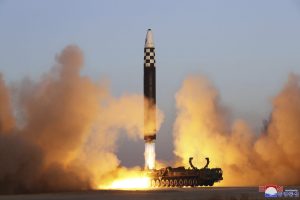Korean Central News Agency (KCNA), one of North Korea’s main state-controlled media, confirmed on Friday that the missile test-fired the previous day was its newest Hwasong-17 intercontinental ballistic missile (ICBM).
“The launching drill of the strategic weapon serves as an occasion to give a stronger warning to the enemies intentionally escalating the tension in the Korean peninsula while persistently resorting to irresponsible and reckless military threats in defiance of the DPRK’s severe warning,” KCNA reported. (DPRK is an acronym of North Korea’s official name: Democratic People’s Republic of Korea.) KCNA said the launch would also “give an understanding of the concern about armed conflict which has come to a threatening reality, and to more clearly show the practical will of the Party and government of the DPRK to counterattack with overwhelming offensive measures anytime.”
The Freedom Shield exercise, a regular springtime joint military drill between South Korea and the United States, kicked off on Monday, March 13, and will end on March 23.
According to the KCNA report, Kim Jong Un, the supreme leader of North Korea, guided the launch. Along with other military officials, he again was accompanied his beloved and respected daughter, Kim Ju Ae, who has appeared at all the North’s major military events since she made her debut in at an ICBM launch in November. Her appearances have reignited debates over Kim’s health and the future leadership of North Korea after the Kim Jong Un era.
While narrating that the missile launch “was aimed at confirming the mobile and normal operation and reliability of the DPRK’s nuclear war deterrent,” KCNA also shared details of the performance of the Hwasong-17 ICBM tested on Thursday.
“The ICBM Hwasongpho-17, launched at the Pyongyang International Airport, traveled up to a maximum altitude of 6,045 km and flew a distance of 1,000.2 km for 4,151 s before accurately landing on the preset area in the open waters off the East Sea of Korea,” KCNA said.
It added, “The drill confirmed the war readiness of the ICBM unit and the exceptional militancy of the DPRK’s strategic forces and strictly verified their reliability.”
Hours after the North’s ICBM launch on Thursday, South Korea and Japan released their analyses on the performance of the missile. Based on the details shared by the North’s state media, South Korea and Japan appear to have accurately tracked the ICBM through their reconnaissance and intelligence systems, as their analyses largely matched the details the North reported.
Stressing the necessity to “strike fear into the enemies,” Kim pledged to keep making counteractions against the U.S. and South Korea “to make them realize themselves that their persistent expanded anti-DPRK military moves will bring an irreversible, grave threat to them,” according to the report.
Apparently, Kim’s tit-for-tat measure to the strengthened South Korea-U.S. military drills is lowering the threshold of his nuclear weapons in order to increase his strategic leverage in the region. Since North Korea promulgated a new law to support the country’s nuclear forces and to set new conditions for using nuclear weapons in September, North Korea seems to have abandoned its previous logic for developing nuclear weapons as a defensive countermeasure option.
With this, Kim appears to be willing to develop more powerful and advanced nuclear weapons, which can be considered as a direct threat to the security of the United States, in a bid to raise the ante in future nuclear negotiations. It also demonstrates the limitations of the U.S. and U.N. economic sanctions against North Korea, as Kim has prioritized the development of nuclear weapons rather than focusing on improving the lives of his people.
Hours after the ICBM launch on Thursday, South Korean President Yoon Suk-yeol held a one-on-one summit meeting with Japanese Prime Minister Kishida Fumio. Considering the report made by the North’s state media, the Hwasong-17 ICBM launch was not aimed at responding to the Yoon-Kishida summit meeting. However, both South Korea and Japan want to strengthen security cooperation to effectively respond to the North’s illicit ballistic missile launches.

































